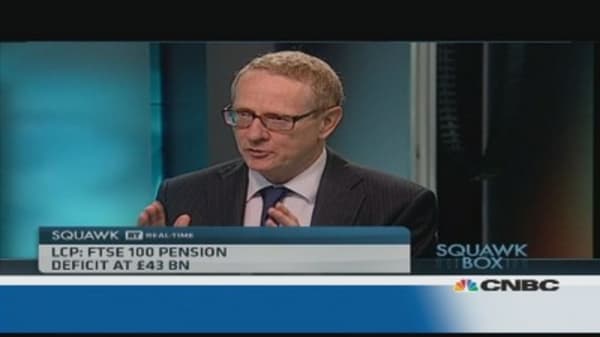Recent reforms by many U.S. cities and states have seen retirement benefits for new hires cut, and their contributions into pension plans raised. It will be several years before these reforms start to have an effect on gaps in pension funding.
As well as stock market gains, pension funds are being helped by relatively low exposure to the struggling bond market.
In the last decade bonds held by public pension funds fell from around one third to around one fourth of assets as yields declined.
According to Wilshire Associate U.S. public pension funds have about 25 percent of assets invested in bonds, compared to an average of 37 percent for corporate funds.
(Read more: Investors eyeball French pension reform plans)
In the longer run, higher yields could even provide a boon for pension funds because of higher returns.
Funding gap could swell under new rules
Funds will need higher returns as they adapt to new accounting rules set to begin taking effect next year.
Alicia Munnell, at the Center for Retirement Research at Boston College, co-authored a report last month showing U.S. state and local public pensions would have been a paltry 60 percent funded in 2012 if measured by the new rules. That compares with an estimated 72 percent for fiscal 2012 under old rules.
The new rules have been issued by the Governmental Accounting Standards Board (GASB). One key provision is to slash projected rates of return for pension funds' unfunded portions from roughly 7.5 percent to a much lower market level. The move will greatly increase the amounts at which unfunded liabilities are calculated and the money states and cities will have to pay into their funds.
Munnell's study showed that if current projected return rates for public funds are reduced nationwide to five percent, the unfunded figure for America's public pensions jumps from $1 trillion (£641.56 billion) currently to $2.8 trillion.
Still, Munnell is warning against alarmism.
"Public plan sponsors have made numerous changes to reduce their pension costs in the wake of the financial crisis and ensuing recession. The market has performed well in the last few years. Let's give the plans the time and space to work their way back to more comfortable funding limits," Munnell said. The funded ratios of state and local pension funds was at 103 percent in 2000, after a decade-long bull market.
Returns could make or break reforms
So far this year, plans such as the California Public Employees' Retirement System, Florida's state fund, Ohio state teachers and Connecticut have reported returns well above 11 percent. Most others are expected to follow suit.
A recent report by Wilshire Associates found that in the 12 months preceding June all public funds had a median return of 12.4 percent, although that declined in the last quarter to just 0.24 percent.
Similar results are reported by Callan Associates, the San Francisco-based investment consulting firm.
A report by the credit rating agency Standard & Poor's said there are signs of stabilization in public pension underfunding.
John A. Sugden, primary analyst on the report, said signs were encouraging but warned against over-optimism.
"Good returns are a positive development," Sugden said. But he said recent reforms, where many states and cities have curbed benefits and increased contributions for new hires, will take a long time to produce results.
Rachel Barkely, a municipal credit analyst at Morningstar, said the new GASB accounting system and the stock market "are the two key factors that will drive the pension conversation for governments over the next few years."
Barkley said stock market returns could change if the Federal Reserve eases off its expansionary policy known as quantitative easing.
"There is a lot of uncertainty on whether and how financial markets will keep delivering good results," Barkley said.




